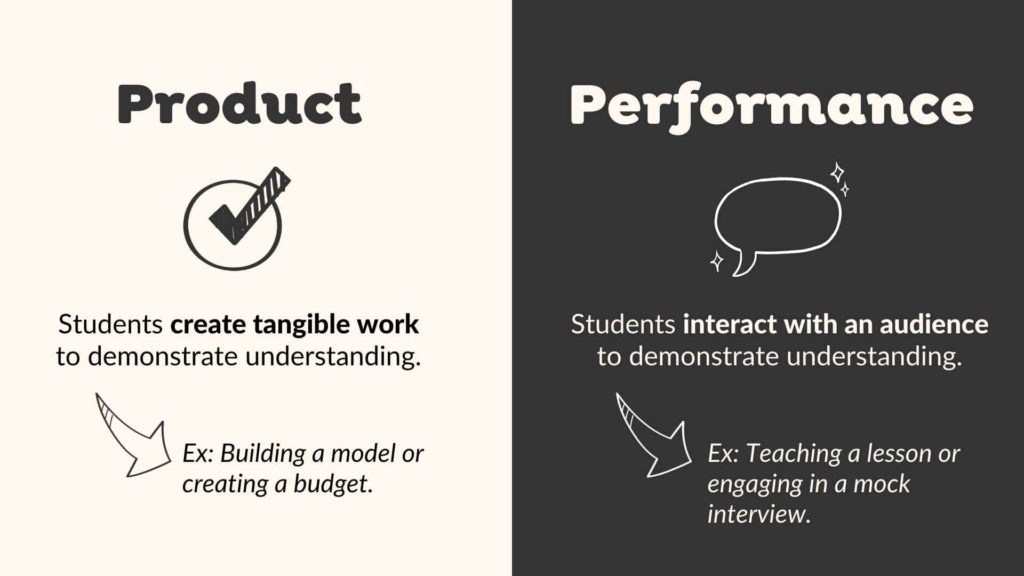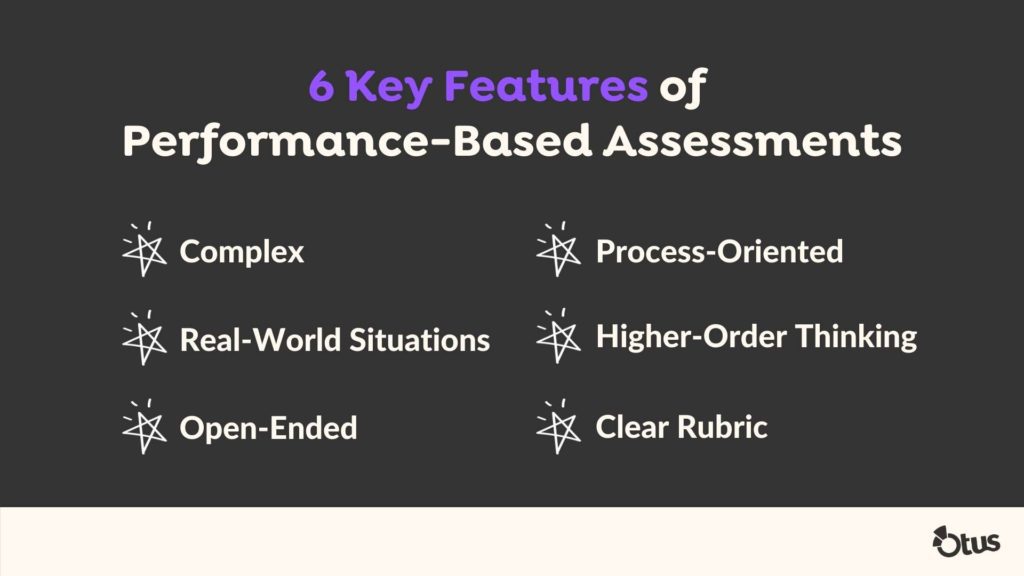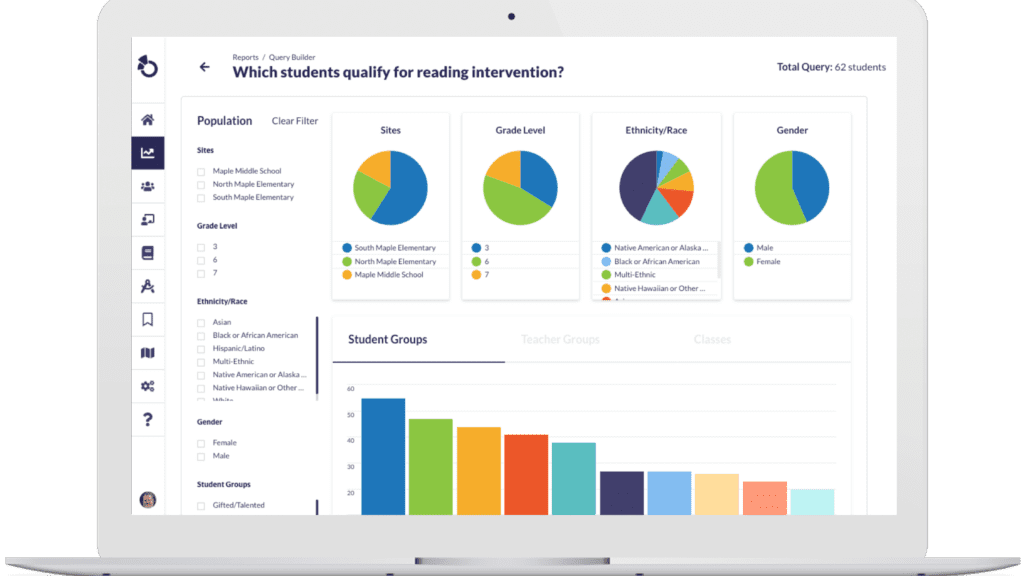The Ultimate Guide to Performance-Based Assessments
What is a performance-based assessment?
Performance-based assessments move beyond multiple-choice and written tests in order to determine not only what students know but how they apply their knowledge. Occasionally called authentic assessments, performance assessments emphasize the importance of “real-world” application.
The real-world emphasis of performance assessments occurs not only in the final assessment – are the skills being assessed translatable to skills students would need to use in the real world? – but also in the ongoing instruction that occurs both before and during the performance assessment.
What are the two types of performance-based assessment?
Generally, there are two broad umbrellas that cover performance-based assessments: performance assessments can end either in some sort of product or some sort of performance.
Typically, a product-oriented performance assessment ends with the students producing some sort of tangible element not only encapsulating the summation of the knowledge they’ve gained but demonstrating that they’ve learned how to apply gained knowledge. For example, a student may grow a garden, create a budget, write an argument, or build a model.
Performance-oriented performance assessments, on the other hand, allow students to interact with an audience to demonstrate their applied knowledge. For example, a student may participate in a debate, perform a piece of music they composed, engage in a mock interview, or teach their class how to cook a meal.

Regardless of which of the two a teacher chooses to end the performance assessment with, it is important that the final grading of either is process-based. True performance assessments value the learning process as much as – if not more than – the final result. The majority of the learning should occur not before the performance assessment begins but along the way.
Additionally, performance assessments highly value processes that move students beyond acquiring knowledge to thinking critically about what they are learning and how they can best apply what they are learning. Whether an assessment ends in a product or performance, students should be able to articulate both how and why they ended their assessment in the way that they did.
What are the key features of a performance assessment?
Proponents of performance assessments argue that traditional tests are passive and do not accurately reflect what a student truly knows and can apply. Thus, performance-based assessments require students to actively engage with the material they are learning in authentic, practical, real-life scenarios.
Although there are no set key features of performance assessments, most writers and educators agree that assessments claiming to be performance-based must include the following elements:
- Performance assessments must be complex. Very rarely in the real world will a person need only one skill to complete a work or life task. Consequently, performance-based assessments must require students to draw from a variety of skills and wells of information in order to complete their assessment. Thus, performance-based assessments are ideal for educators wishing to collaborate across departments and subjects.
- Performance assessments must be authentic to real-world situations. The underlying purpose of performance assessments – and of education itself, according to most educators – is to ensure students are prepared to leave school ready for any challenge. Thus, a solid performance-based assessment will reflect scenarios students may face outside the school setting.
- Performance assessments must be open-ended. Just as we rarely find real-life situations with only one right solution, well-written performance assessments allow students to explore the topic in a way that they could potentially arrive at a number of “correct” solutions, or present a final product in a variety of different ways and still receive full credit.

- Performance assessments must be process-oriented, and often have an end product to present. Similar to the open-ended point, performance assessments are most successful when students have multiple ways of accomplishing them. The best performance assessments provide students with opportunities for exploration, learning, analysis, and other higher-level thinking processes as they complete the task. The final score isn’t entirely about the end result, but rather rests heavily on how students used what they know to get to the end result. Often - although not always - students will have some sort of product to present at the end of their assessment. Although this may be some sort of creative work, it can also be something as simple as a decision or a recommendation. For example, students may have had to compare several different types of job offers in which they analyzed the different types of salaries, health insurance plans, retirement, and other options, and balanced those against their budgets including rent, groceries, and other expenses, as well as their own talents and passions, and decided on which job they should take.
- Performance assessments must require higher-order thinking. In performance assessments, the score does not rest on the final result, as mentioned above. Instead, a large portion of a student’s score comes from the students’ ability to demonstrate that they have the knowledge and skills to complete the assessment successfully. In performance assessments, students must demonstrate problem-solving, critical thinking, and analytical reasoning skills. Most performance assessments require students to synthesize, apply evidence, analyze, critique, judge, and more in order to pass. This ensures that teachers are able to see that student learning has truly transferred to their ability to apply what they have learned to real-life situations.
- Performance assessments must be graded on a clear rubric. It is important before beginning that students understand exactly what is expected of them, especially as many will have never been given this type of open-ended assessment based on performance before. Students will not be able to successfully explore and create if they don’t clearly understand their boundaries. Additionally, the rubric should have a clear timestamp. Performance-based assessments can range from taking a few hours to a few months. There’s not a correct time frame; however, it must be clear at the outset. It’s not wrong to set up a tight timeframe either; often in the real world, there are very quick time turnarounds to complete projects.
Why are performance-based assessments important?
Due to the constantly expanding reach of technology and its dramatic impact on almost every area of life, job expectations and even jobs themselves are constantly changing and evolving. It’s no longer enough to teach students knowledge; students can find that knowledge with a few clicks of a mouse. Instead, teachers must teach students how to use that knowledge in equally evolving, creative ways.
Traditional assessments - while helpful for some forms of assessments - simply aren’t enough anymore to ensure students are leaving school well-prepared for real life and the constant changes it brings.
The major advantage of performance-based assessments, on the other hand, is that they do exactly that. Teachers can be confident that students who pass performance-based assessments are ready to face the challenges of the real world with creativity, analysis, and excellent problem-solving skills because those skills are exactly what performance assessments are designed to impart to students.
Performance assessments require students to take what they have learned and not simply recall it but apply it in a variety of ways to different situations. They provide students with the opportunity to not only find the knowledge they need to solve a problem but find ways to process and analyze that knowledge to make a good – not ‘correct’ - decision.
Moreover, another advantage of performance-based assessments is that students are not focused fully on the end product but on how to get there. This encourages a love of learning, as well as increased metacognition as they process where they are and what they need to learn to get where they want to be. As part of their scoring, they must be able to articulate not only their ‘final answer’ and product but explain how they got there. Performance assessments build communication with others as well as self-reflection, both of which are essential skills in today’s world.
Performance-based assessments encourage students to make good decisions rather than search for the correct answer.
Finally, one of performance assessments’ greatest advantages is that they allow students to see how many different subjects not only overlap but how they are useful and applicable in the real world. This usually has the effect of motivating students to learn and invest effort as they see how the assessments – and the learning that comes along with it – will benefit them in the long run.
What do teachers do in performance-based assessment?
It is important that teachers interested in moving toward performance-based assessments understand that it is a significant amount of work in the beginning. It takes far more time to set up than more traditional approaches to instruction and assessment. However, what time teachers may feel like is lost initially is more than made up for during the assessment process. Many teachers find themselves in more of a “guide” position, coming alongside students as the students take ownership of their learning exploration.
To begin a performance-based assessment, teachers must actually think first about the very end goal. What standards and learning objectives do the teachers want to measure? The entire assessment must be designed backward from this starting - or ending - goal.
Then teachers must consider what type of process or product students could complete demonstrating mastery of these standards and objectives. As they design the performance assessment, teachers must ensure the assessment is complex, allowing students the opportunity to apply a variety of skills and knowledge, ideally across subject areas; is authentic, allowing students to practice applying their skills to real-world situations; is open-ended, allowing students to explore a variety of solutions instead of reaching only one narrow “right choice;” is truly process-oriented, allowing students to explore and learn during the process; and requires higher-order thinking, challenging students to move beyond retention towards application.
See How Otus Makes Rubric Grading Easy

It is important then for teachers to create very clear rubrics. These performance rubrics should highlight the standards and skills to be mastered and demonstrated but should leave room for the students to determine at some level how they will demonstrate mastery. There should be some element in the rubric that requires students to explain how they developed their final product, supporting it with evidence and analysis. Rubrics should clearly outline the timeline for the project.
Additionally, teachers may want to brainstorm a variety of formative assessments they can give along the way to ensure students are on the right track. Teachers should have intervention plans in place if students do not perform as expected on the formative assessments.
Once all of these elements are in place, teachers must determine the best way to clearly explain the performance assessment to the students. As many performance-based assessments are done in tangent with a teacher’s instruction, even incorporating that instruction into the assessment, it is usually best to introduce the assessment along with the unit introduction. Often teachers will tie these together with one or more open-ended questions to guide the unit.
It is also important for teachers to take the time to help students understand the authenticity of the performance assessment – how developing the skills across disciplines and applying them to the performance assessment will help them tackle similar real-life situations outside of school. Only then can teachers expect the buy-in helpful in making performance-based assessments such valuable learning tools.
Related Resources
Request a demo!
See exactly how Otus can help your school accelerate student growth and improve student outcomes – all while saving educators time.




